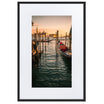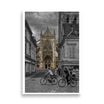Make a Frame: Complete Guide to Creating Your Own Frames
Introduction
Making a custom frame is a creative and rewarding way to display your artwork, photographs or memorabilia. As well as giving your home decor a personal touch, creating your own frames allows you to tailor them to your needs and style. This comprehensive guide will provide you with all the information you need to make a frame, from the materials to use to the steps involved, to practical tips for a professional result.
Why Make a Frame?
1. Personalization
Making a frame allows you to choose the materials, dimensions and style that perfectly match your interior decoration and highlight your works.
2. Economy
Making your own frames can be more economical than buying ready-made frames, especially if you need specific sizes or custom frames.
3. Personal Satisfaction
Creating a frame with your own hands is a rewarding experience. You can express your creativity and have the satisfaction of having made something beautiful and functional.
Materials and Tools Needed
1. Materials
- Wood : Use wooden cleats for the frame uprights. You can choose different types of wood depending on the desired aesthetic.
- Glass or Plexiglas : To protect the artwork, you will need a pane of glass. Plexiglas is a lightweight and unbreakable alternative.
- Backing board : A piece of cardboard or plywood to hold the artwork in place behind the frame.
- Fasteners and Brackets : Fasteners to secure the glass or plexiglass, and brackets to hang the frame on the wall.
- Nails or Staples : To assemble the frame uprights and secure the backing board.
2. Tools
- Saw : A miter saw for cutting wood strips to the correct size and angle.
- Tape Measure : To measure the dimensions of the frame.
- Wood Glue : To assemble the corners of the frame.
- Sander or Sandpaper : To smooth cut edges.
- Hammer or Stapler : To assemble the frame and secure the backing board.
- Clamps : To hold the corners of the frame in place while the glue dries.
Steps of Making a Frame
1. Measure and Cut the Cleats
- Measure the size of the artwork you want to frame.
- Cut four pieces of wood to the required dimensions, making sure to cut the ends at a 45 degree angle to form the corners of the frame.
2. Assemble the Frame
- Apply wood glue to the ends of the cleats.
- Assemble the cleats to form a rectangle, making sure the corners are aligned.
- Use clamps to hold the corners in place while the glue dries.
- Once the glue is dry, reinforce the corners with nails or staples for added strength.
3. Sand and Finish the Frame
- Sand the edges and corners of the frame to remove any rough spots and make them smooth.
- Apply a finish to your frame, such as paint, stain, or varnish, depending on your desired aesthetic.
4. Add Glass or Plexiglas
- Cut the glass or plexiglass to the inside dimensions of the frame.
- Place the glass or plexiglass in the frame, against the interior rebate.
- Use clips to secure the glass or plexiglass in place.
5. Fix the Work and the Background
- Place the artwork in the frame, face down against the glass or plexiglass.
- Place the background cardboard behind the artwork.
- Use nails or staples to secure the backing board to the frame.
6. Install the Wall Brackets
- Attach brackets or clips to the back of the frame to allow it to be hung on the wall.
- Make sure the brackets are centered and securely fastened to prevent the frame from leaning.
Practical advice
1. Accuracy of Measurements
Be sure to measure accurately so the frame corners fit snugly. Inaccurate cutting can result in gaps between the cleats.
2. Choice of Wood
Choose a good quality wood that will not warp over time. Pine, oak and maple are excellent choices for their durability and finish.
3. Creative Finishes
Experiment with different finishes to personalize your frame. You can paint, stain, varnish or even decorate the wood with patterns for a unique look.
4. Use of Anti-Reflective Glass
For artwork that will be displayed in brightly lit areas, consider using anti-reflective glass for better visibility and protection.
5. Secure the Work
Make sure the artwork is secure and won't slide around in the frame. Use conservation tape or cardboard corners to hold the artwork in place without damaging it.
Conclusion
Making a custom frame is a creative and satisfying way to display your artwork and photographs. By following these steps and tips, you can create frames that not only protect and showcase your artwork, but also add a personal touch to your home decor. Whether you’re a beginner or an experienced DIYer, making your own frames is a rewarding activity that will enhance your creations and memories.
FAQs
What materials are needed to make a frame? Materials needed include wood slats, glass or plexiglass, backing board, fasteners and brackets, nails or staples, and wood glue.
What type of wood is recommended for making a frame? Pine, oak, and maple are popular choices because of their durability and beautiful finish. Choose a good quality wood to avoid warping.
How to secure glass or plexiglass to the frame? Cut the glass or plexiglass to the inside dimensions of the frame, place it in the frame against the inside rabbet, and use clips to hold it in place.
How can I customize the finish of my frame? You can customize the finish of your frame by using paint, stain, varnish, or adding decorative designs. Experiment to create a unique look.
Why use anti-reflective glass for frames? Anti-reflective glass reduces annoying reflections and improves the visibility of the work, especially in brightly lit areas. It also provides better protection against light.




































































Leave a comment
All comments are moderated before being published.
This site is protected by hCaptcha and the hCaptcha Privacy Policy and Terms of Service apply.